Brothers in Right Ideology
“Hindu of India — with Putin! Russia restores the Soviet Union. Long live unbroken Russia!” – such posters appeared on the monument to Alexander Pushkin in New Delhi just a few days after the start of the Russian invasion of Ukraine. They were installed by representatives of the ultranationalist movement Hindu Sena ("Hindu Army" or "Hindu Army"). This action was widely publicized in India and was heavily criticized by the Indian opposition. The police removed the posters and called the defacement of the monument unacceptable. However, no one was brought to justice, although the head of the Hindu Sena himself admitted that the action in support of Putin was their doing.
“We pray and support Russia, which is collecting its old territories of the USSR and doing everything to protect its borders,” said the head of the movement, Vishnu Gupta. “Choosing between good and better, we choose the side of Russia, which has always supported India.”
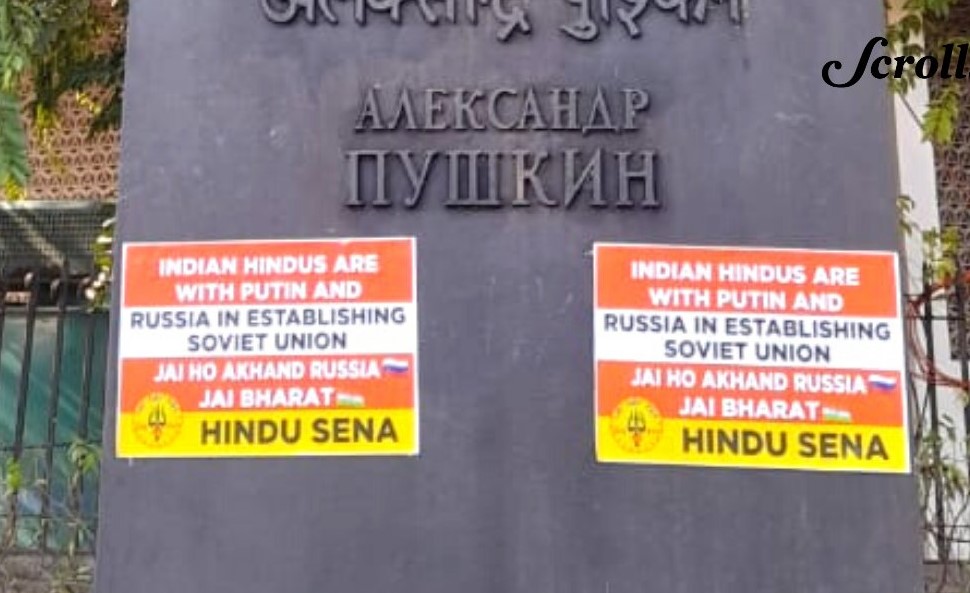
The Hindu Sena political group is present in 16 Indian states and has over a million followers on social media. The movement promotes right-wing and Islamophobic ideas. Its supporters advocate the creation of a "united India" based on the ideology and religion of Hinduism. This empire, according to their plan, should include almost all the states of South Asia, even such predominantly Islamic countries as Pakistan and Bangladesh. Indian politician and public figure Kavita Krishnan believes that supporters of the right strongly influence public opinion in India and work in a pro-Russian direction.
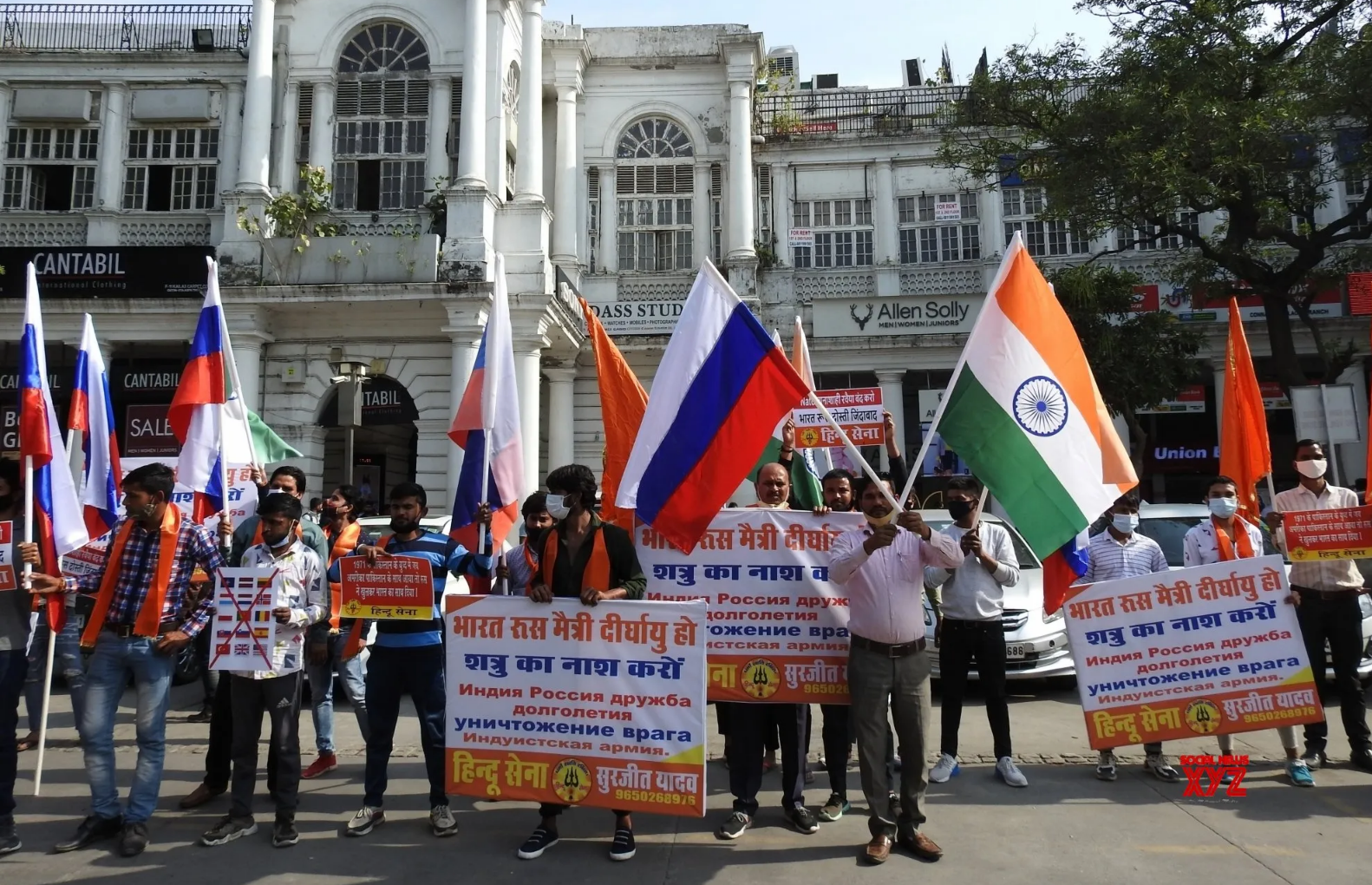
“Hindu Sena adores Trump and Putin because Hindu supremacy throughout history has had similarities and relationships with fascist and far-right movements around the world,” says Krishnan, who has studied public opinion in India in the context of the Russian invasion. It is not known whether the Hindu supremacist groups and Russian authorities are directly connected, but they do share an ideological affinity, The Insider's interviewee speculates:
"The Russian fascist ideologue Alexander Dugin uses the Indian term 'Kaliyuga' in its classic caste sense to designate an anarchic and apocalyptic overthrow of established hierarchies."
Pro-Russian activities to attract allies
As The Insider learned, some Hindu Sena supporters received an invitation to the Congress of the international Russophile movement, founded by a former member of the Bulgarian parliament accused of espionage. Joint forums on socio-political topics are one of the Kremlin's ways to expand the ranks of its supporters, which is especially important for a country that has found itself in international isolation. Invite, however, not only the right. Russian diplomatic missions literally persuade foreign journalists and politicians to attend pro-Russian events.
An invitation letter from the Russian ambassador to India (available to The Insider) states that "participants may be asked to speak publicly in defense of their position, which is expected to be consistent with the goals of the forum." Some Indian journalists are known to have ignored this invitation. “They were very angry when I refused. But I’m so tired of all this,” one of the journalists invited to the forum complained to The Insider.
On the territory of India, the Russian side invites Indian journalists and officials to events at consulates, cultural centers and other organizations of Rossotrudnichestvo, a structure that promotes the Russian point of view on the war with Ukraine. And he does it very successfully – the Indian authorities do not prohibit such events.
In March, the Russian Cultural Center in Chennai opened the exhibition “Nine Years in the Native Harbor”, dedicated to the “annexation” of Crimea. India has allowed the exhibition, although the country is uncompromising about its own disputed territories: for example, it is forbidden to bring maps that attribute the territories of Kashmir to Pakistan here.
In the same place, a few days before the first anniversary of the invasion, the exhibition "Ordinary Nazism", provided by the Moscow Victory Museum, was held. According to this project, power in Ukraine is concentrated in the hands of the successors of Ukrainian nationalists during the Second World War, which explains the need for a Russian invasion and “liberation” of Ukrainian lands.
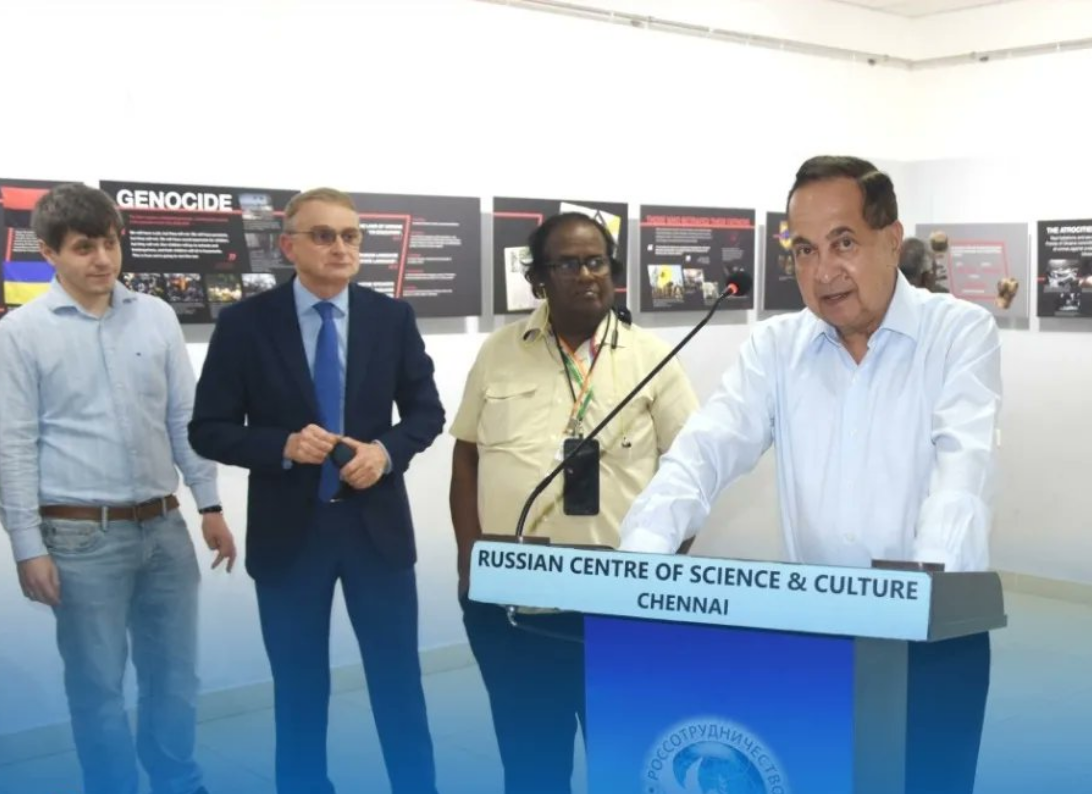
Kremlin propaganda on Indian channels
Indian Prime Minister Narendra Modi makes no pro-Russian statements and refrains from publicly supporting Putin on Ukraine. Nevertheless, his supporters are mostly pro-Putin, says Kavita Krishnan.
While Western countries are shutting down Russian propaganda resources, in India, on the contrary, new ones are appearing: in September 2022, RT Hindi in Hindi and RT English India began broadcasting in India. Russian diplomats, employees of the embassy and cultural centers of Russia speak in the Indian media – again, in contrast to Western countries, where the Russian side has practically no platforms for disseminating its theses. Even Modi's opponents, primarily the left, are broadcasting a similar view, Krishnan says:
“One of India's most senior and respected journalists, Narasimhan Ram, known for his leftist views, visited the Ordinary Nazism exhibition. He delivered a speech , repeating Putin's words that the history of the Russian Orthodox Church (in particular, the baptism of Prince Vladimir) proves that Ukraine is connected with Russia, and Zelensky is trying to break these ties.
Admiral Vishnu Bhagavat, a former Indian Navy chief of staff who Krishnan says opposes Hindu supremacy, has consistently argued that Ukraine is a puppet of the US and NATO. It is she who is the real aggressor, leaving Russia no choice but to make a “strategic intervention,” as he called the invasion a month after it began. Similar statements were made by former Indian Ambassador to Russia, career diplomat Venkatesh Varma. He said that "the Ukrainian conflict is an example of a proxy war between Russia and the West."
The Russian authorities traditionally accuse the West of neo-colonialism, and this is the main thesis they are promoting in India, where the memory of its own colonial past is strong. Among other things, calls for solidarity within the BRICS, Euroscepticism and criticism of NATO, as well as other anti-globalization narratives.
However, not everyone in India is ready to listen to the Kremlin's propaganda. The Russian Embassy in India, on its Twitter, tried to force the Indian media not to use the word "war", but instead to call it a "special military operation". This remark caused a scandal – Indian Twitter users ridiculed the embassy in response.
“Regarding the crisis in Ukraine, a request to the Indian media to be precise so that the Indian public receives objective information,” the Russian diplomatic mission said in a tweet.
“Lol, this is a perfect example of propaganda”, “Russia, please stop advising us”, “Why the hell is the embassy giving instructions to another country?” — wrote in response to some users.
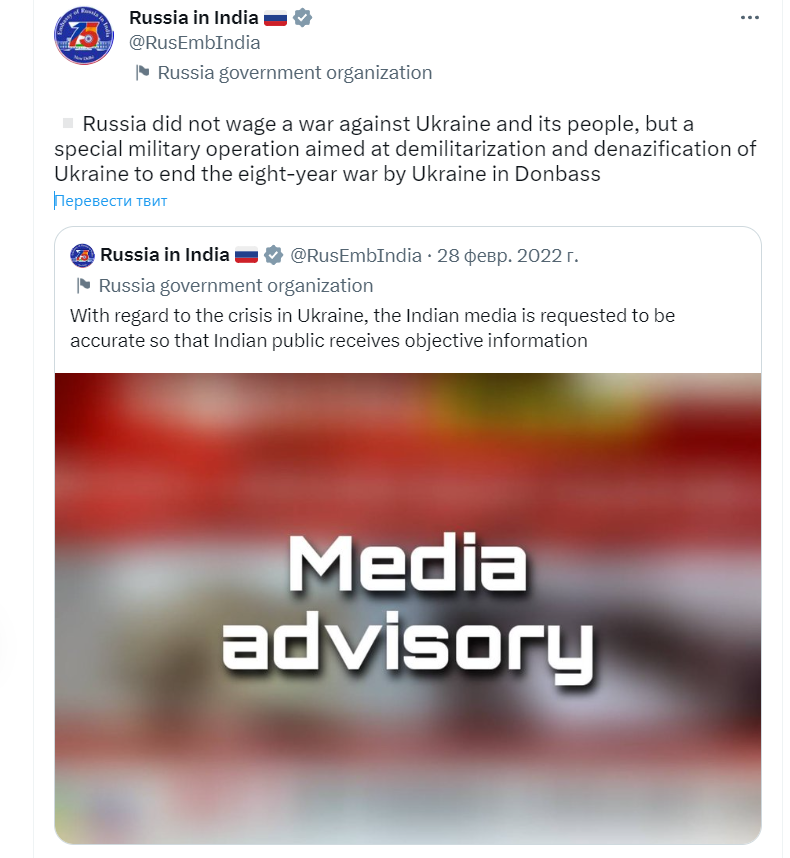
Russian Foreign Minister Sergei Lavrov felt the negative attitude towards propaganda from his own experience. He was publicly ridiculed at the Raisina Dialogue security conference in New Delhi when he tried to explain Russia's invasion of Ukraine as an attempt to "end the war". When Lavrov declared: “You know, the war that we are trying to stop, which was unleashed against us using the Ukrainian people,” laughter broke out in the hall. This reaction infuriated the Russian minister. “I hope that the next meeting will be held in a less tense atmosphere. Can you promise it?" the moderator asked. Lavrov replied irritably: "Your American colleagues will provide you with questions that you can ask."

State Department spokesman Ned Price said this "loud laugh" indicates that Moscow is losing the information war over its invasion of Ukraine. But the London-based Center for Analysis of Social Media disagrees and believes that the international community underestimates the Russian threat – at least in social media.
Bot training ground and "face theft" for Putin
After the invasion of Ukraine, Russia launched information campaigns on Indian social networks with the help of “troll factories”. One such campaign was discovered by the Center for Social Media Analysis in London. The rapid and widespread spread of the #IStandWithPutin and #IStandWithRussia hashtags on Twitter was recorded over two days, March 2 and 3, 2022. At the same time, almost 11% of all messages were published by accounts from India. Only 0.3% were from Russia and 1.6% from the United States.
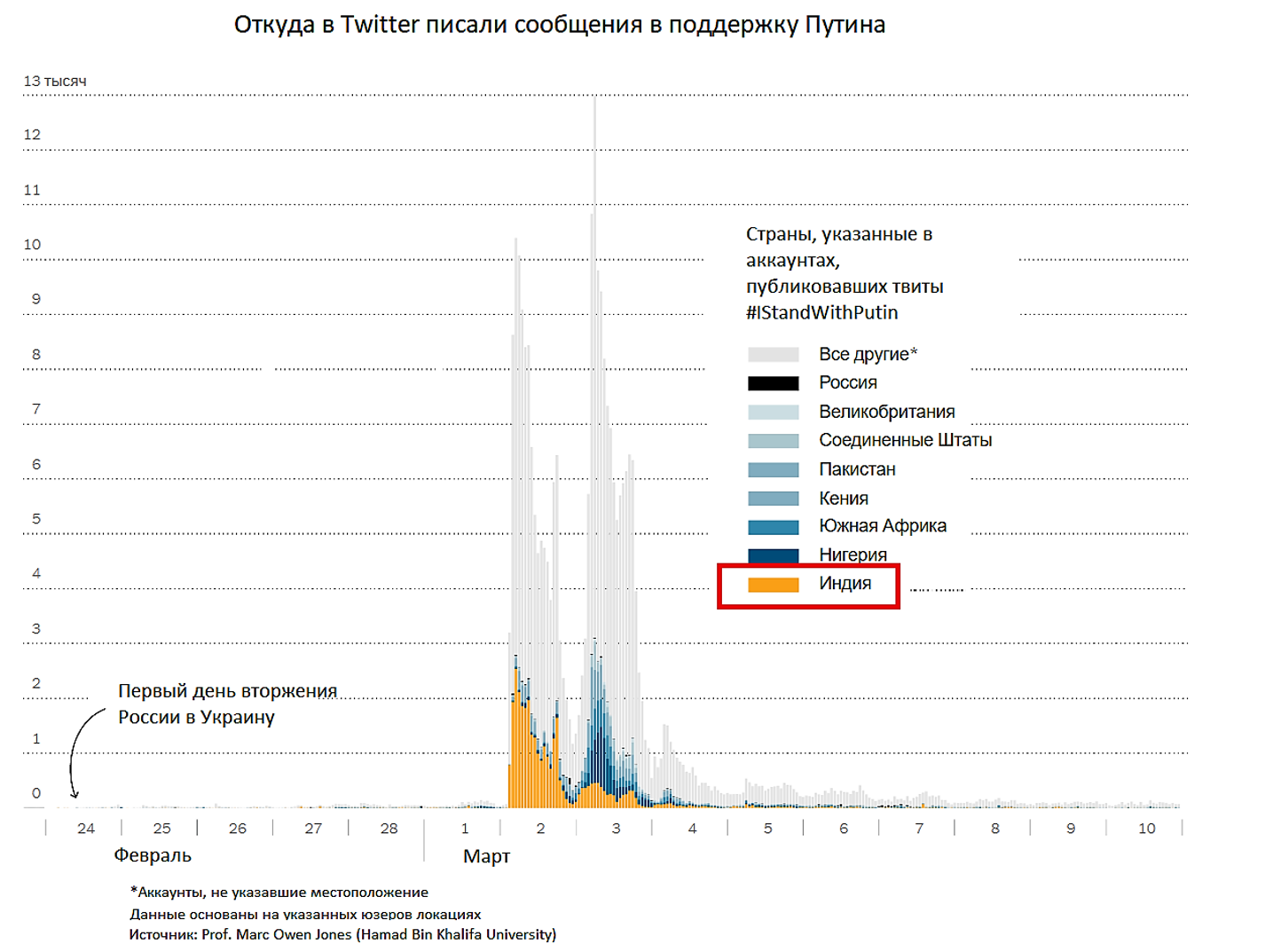
The researchers collected 23 million tweets with pro-Putin hashtags and established 10,000 accounts associated with them. These were accounts that sent five or more tweets. Then we studied the languages in which the accounts were kept and identified three main clusters – in Hindi, Tamil and English.
The Hindi group includes 566 accounts that suddenly posted or reposted 4 million pro-Russian messages in English. This group has the most retweets of other people's posts. Judging by the pre-war posts in support of Narendra Modi, his BJP party, campaign materials and calls to go to local pro-government political rallies and events, the group is loyal to the current Indian authorities.
“There was a sharp spike in pro-Russian activity on March 2 and 3, then a sharp decline, and then they went back to Indian politics and did not comment much on the invasion,” says CASM director Carl Miller.
The second cluster is accounts in Tamil. There are only 228 users who sent 1.7 million tweets. In pre-war messages, account holders opposed Modi and his party. “It looked like an interaction with Tamil politicians from South India who are opposed to the current government,” explains Carl Miller. But on March 2 and 3, these accounts began to massively share exactly the same posts justifying the Russian invasion as the accounts from the Hindi cluster. The third cluster is the largest, with 1,314 Indian accounts in English and Modi loyalists.

In all three clusters, there were almost no accounts with a large number of followers. Nevertheless, pro-Russian tweets received hundreds and thousands of reposts. “There are definitely signs of automation in the network, as evidenced by the move to English-language intrusion messages and then back to Hindi,” Miller said. – It's well coordinated. It could be a series of campaigns linked by a common goal.”
The pro-Russian campaign could have been timed to coincide with the UN vote on a resolution condemning Russian aggression, Miller suggests. And her goal was to create the illusion that support for the Russian invasion in Indian society is higher than it really is.
Some accounts used photos of Indian influencer bloggers as their avatar. So, the popular Indian insta-blogger Er Yamini found her photo on the avatar of a Twitter account that replicated hashtags in support of Putin and Russia. “I am with Putin (#IStandWithPutin). True friendship,” read one post with a video of two men embracing, apparently symbolizing the friendship between India and Russia.

Nicole Thorne is an influential blogger with 1.5 million followers on Instagram, lives in Australia and barely uses Twitter. She found her photo on the avatar of a pro-Putin account under the name Preity Sharma. The user description read: “Entrepreneur and model, originally from India, now in Miami.” The profile was created on February 26, 2022, two days after the Russian invasion of Ukraine. “Putin is a good person,” one of the retweets says.
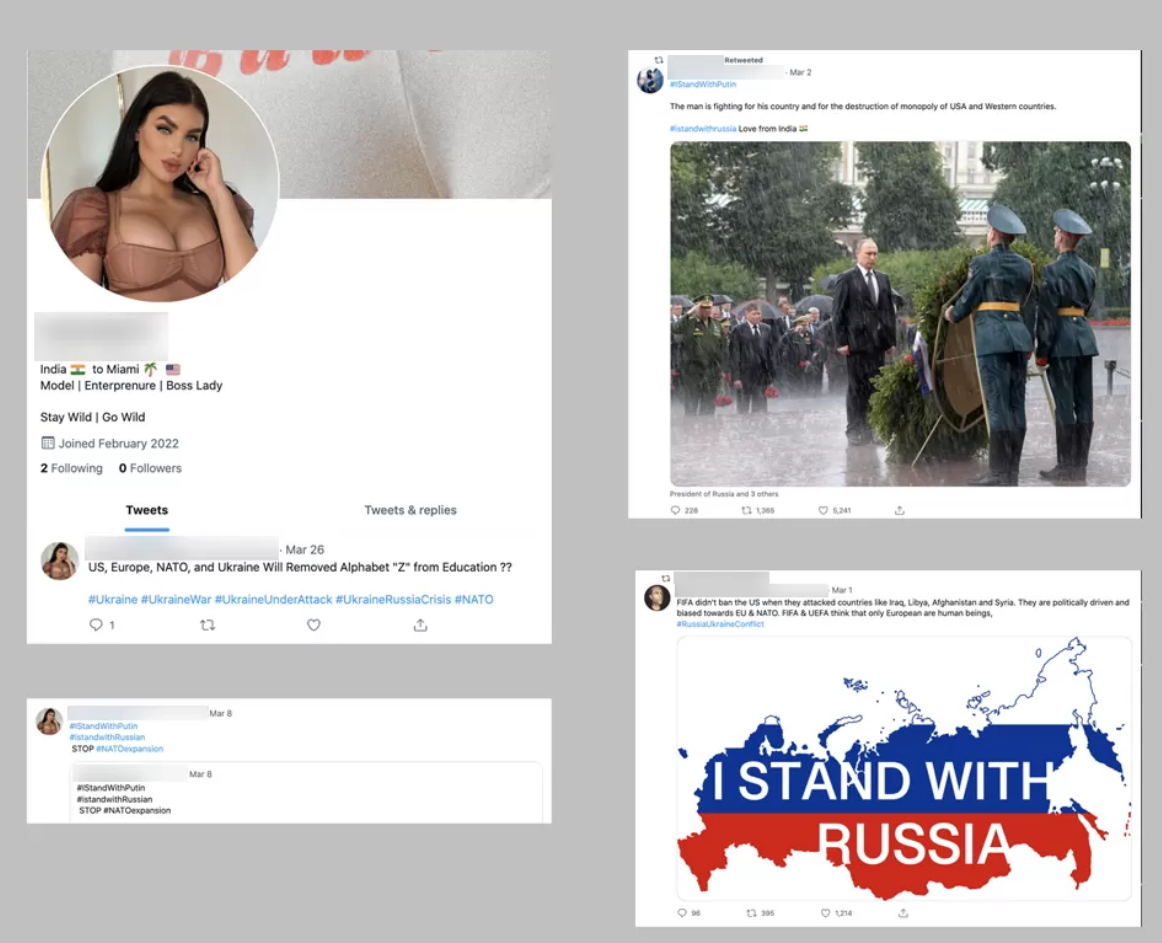
Another account tried to impersonate Indian singer Raju Gujjar. The first tweet was published on February 24, and all 178 posts of the account are retweets. This is one of the main signs of a bot, experts say. The BBC contacted the real musician, who confirmed that the account was not his.
According to the BBC, Twitter leadership has since the start of the war deleted more than 100,000 accounts, including blocking dozens of accounts associated with the hashtags #IStandWithRussia and #IStandWithPutin.
Reasons for justifying the invasion
In the imagination of Indians, Russia is a very friendly country, and many do not believe that it is capable of any atrocities, social activist Kavita Krishnan explains:
“The reasons are partly in the fact that the Soviet Union was seen as a benefactor of India during the Cold War, and also in the tendency to correlate Russia and the USSR. Ukraine has historically occupied very little space in the Indian imagination.”
Some media have gone even further, taking an aggressively pro-Russian stance, Krishnan says. First of all, these are YouTube channels, TV channels and Internet publications of a conservative Hindu persuasion, advocating the nationalist policies of Narendra Modi and more radical movements. But even relatively independent YouTube channels are spreading conspiracy theories, such as that the United States is producing bioweapons in Ukraine.
“One TV station, broadcasting in Hindi and several other Indian languages, boasts of 'around the clock coverage' of the invasion,” Krishnan says. During Xi Jinping's visit to Moscow, this channel aired screaming Hindi headlines such as "Beijing and Moscow – stop if you dare!", "Doomsday for Ukraine and for America", "Xi greeted Putin with atomic salute."
Perhaps certain media are doing this out of ideological proximity or simply because they lack content. Whether any other incentives are offered remains to be seen, Kavita said. However, bribery of Indian channels was also practiced in Soviet times. In 1977, the KGB supported ten newspapers and one news agency, with the assistance of the KGB, it published more than 5.5 thousand articles and notes.
Journalists "on the payroll" of the Soviet government
The penetration of the Soviet intelligence network into Indian political life was massive. It started in the 1950s when the Soviet Union, after India gained independence, trained employees of the Indian Intelligence Agency (Investigation Bureau, IB).
“The size and dynamics of Moscow’s political apparatus in India is such that it is unlikely to be easily disabled,” argued the authors of a 32-page CIA report on the involvement of Soviet intelligence in the country and declassified in 2011. It said that the board members and journalists of many media outlets were "on the payroll" of the Soviet government.
The same is said in the archives of Vasily Mitrokhin, the former head of the archival service of the First Department of the KGB. In 1992, he fled to the UK and handed over to London about six suitcases of materials on the work of Soviet intelligence, including in India.
According to these archives, the number of KGB agents in India during the 1970s was the largest outside the Soviet Union. In 1978, more than 30 Soviet agents worked there, 10 of which were Indian intelligence officers. In 1977, the Soviet secret services financed the election campaigns of more than 20 politicians. Several ministers and regional leaders of India were on the payroll of the KGB.

It was Soviet intelligence that persuaded Indian Defense Minister Krishna Menon to buy Soviet MiGs rather than British Lightnings, and his election campaigns in 1962 and 1967 were funded by the KGB, the documents say. In 1975, the USSR spent 10.6 million rubles on activities to increase support for Indira Gandhi and undermine her political opponents. Gandhi herself in the KGB received the operational pseudonym "Vano". She was not an agent of the Soviet special services, but the influence of the KGB on her and the Indian National Congress (INC) party was total. A secret gift for the INC in the amount of 2 million rupees was personally delivered by the head of the KGB in India, Leonid Shebarshin. Another million rupees was donated to a newspaper supporting Indira Gandhi. Soviet intelligence also sponsored the Communist Party of India (CPI), which in the 1970s became close to Gandhi's party – money for the CPI was sometimes transferred "in bundles through car windows on the streets of New Delhi."
The KGB did everything to strengthen Indira Gandhi's distrust of Washington. She and her entourage were regularly planted materials about the opposition's connections with the American intelligence services, according to the archives. This eventually resulted in a real paranoia in Gandhi. Not a single decision of India at that time was contrary to the interests of the USSR.
In the 1990s and 2000s, the activities of the Russian special services in India changed their profile. Instead of interfering in political life, agents used the country as a springboard for work in other areas, in particular, in Afghanistan, where hostilities were taking place between the Northern Alliance of Ahmad Shah Massoud and the Taliban, and Al-Qaeda was also strengthening.
Rapprochement of India and the USA
Against this background, there was a rapprochement between India and the United States. А в 2020 году Вашингтон и Нью-Дели подписали основополагающее оборонное соглашение — «Базовое соглашение об обмене и сотрудничестве» (BECA) в военной сфере. Эксперты предполагают, что это «сближение с врагом» заставило Россию активизировать агентов ГРУ. Сейчас Нью-Дели следит за российскими разведчиками и оценивает вероятность их вмешательства во внутренние дела Индии, включая выборы, говорится в статье Sunday Guardian со ссылкой на источники во властях Индии. Воздействие, по их данным, вероятно, будет осуществляться через соцсети. О каких-либо арестах или обвинениях в связи с советскими/российскими спецслужбами неизвестно.
«Россия обладает высокоэффективной инфраструктурой и подразделениями для запуска киберкампаний. Мы знаем о проблемах, которые могут возникнуть в ближайшем будущем из-за недавних событий, в частности, договора BECA, заключенного между Нью-Дели и Вашингтоном», — заявил изданию индийский чиновник.
Еще один фактор, который пошатнул российско-индийские отношения, — усиление зависимости Москвы от КНР, в первую очередь технологической. Это сделало Россию крайне ненадежным партнером для Индии, считает бывший министр иностранных дел Индии, а ныне депутат парламента Шаши Тхарур:
«Перед лицом растущей воинственности Китая это (укрепление отношений Пекина и Москвы) предвещает беду для Индии, которая должна срочно пересмотреть свою давнюю дипломатическую и стратегическую зависимость от слабеющей России».
Пересмотреть отношения с Москвой Индии не давала в первую очередь зависимость от вооружений, считает Тхарур. Но в последние годы Индия диверсифицировала поставки и переходит на оружие других стран. Причем сделала она это вынужденно — из-за систематического неисполнения Россией контрактов. О том, что Москва не смогла выполнить обязательства на поставки оружия, сообщило Минобороны Индии в отчете для парламента.
«В этом году была запланирована крупная поставка, которая не состоится. Они [россияне] сообщили нам в письменном виде, что не смогут ее обеспечить», — цитируется в документе представитель ВВС Индии. По данным CNN, речь может идти о ЗРК С-400 «Триумф» на сумму в $5,4 млрд. Три комплекта этих систем были ранее поставлены, еще два ожидаются. Также могут быть приостановлены поставки запчастей для Су-30МКИ и МиГ-29. Еще один контракт — межправительственное соглашение стоимостью $1 млрд на поставку 200 вертолетов — Москва и Нью-Дели заключили в 2015 году, но с тех пор Индия не получила ни одного и заморозила переговоры. И это несмотря на готовность России передать технологии и наладить производство 140 Ка-226Т в Индии. В мертвой точке и сделка по поставке Су-30МКИ. Россия предложила Индии комплекты для производства истребителей на ее территории на $1,4 млрд. Но контракты, которые планировалось подписать в 2020 году, так и не заключены.
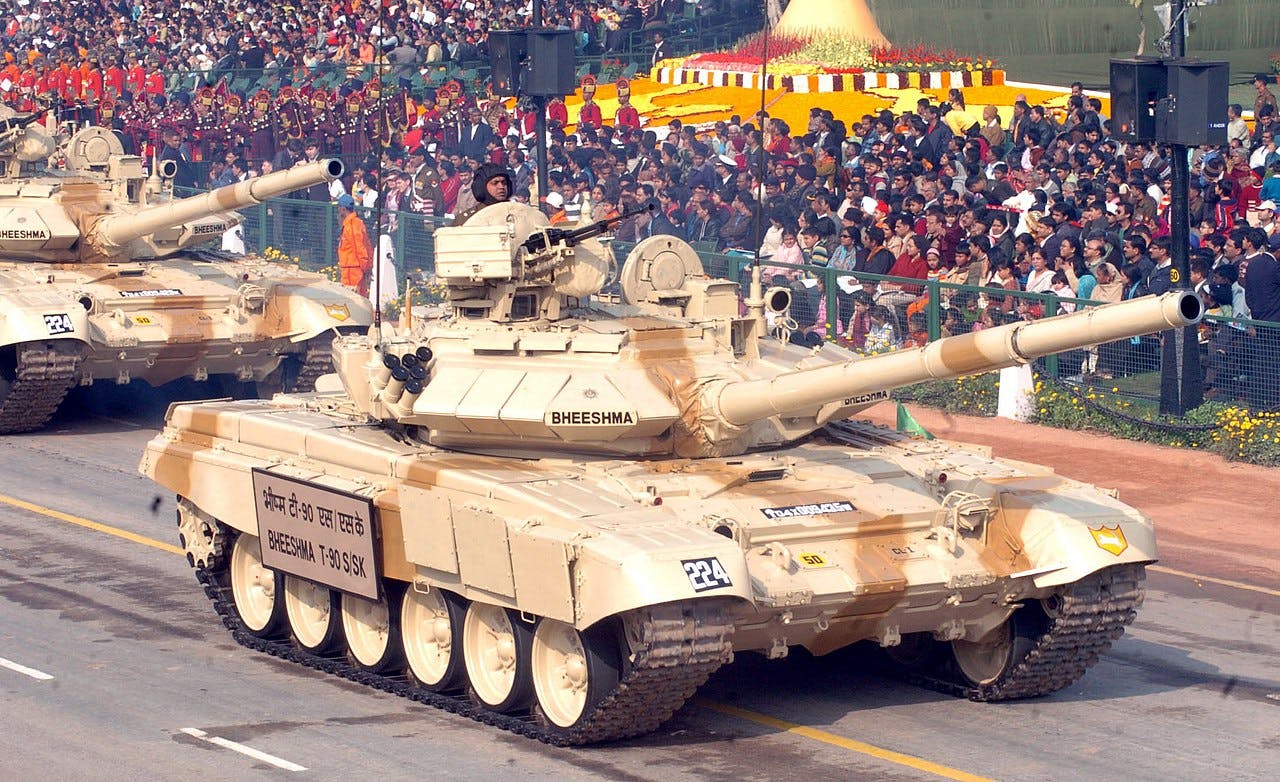
В итоге, если в 2006–2010 годах около 75% вооружений были российскими, в 2016–2020 годах — менее 50%, то сегодня — примерно 45%, отмечает Тхарур. Ключевыми поставщиками становятся США, Франция и Израиль. По данным Стокгольмского международного института исследований проблем мира (SIPRI), за последние пять лет экспорт российского оружия в Индию упал на 37%.
Помимо этого, Нью-Дели рассматривал Москву как силу, способную удержать Пекин от посягательства на приграничные индийские территории. Но после того как Москва стала лучшим партнером Китая, Индия не может положиться на нее. И Нью-Дели вынужден сотрудничать с другими странами для сдерживания «самонадеянных амбиций Китая». Он также предупредил о возможности появления новой оси Пакистан — Китай, которая будет исключительно враждебна для Индии. Москва займет в лучшем случае двойственную позицию, в худшем — станет участником этой оси.
«Россия в обозримом будущем, сильно ослабленная украинской авантюрой, — это не та Россия, на которую Индия может положиться», — отмечает Тхарур. При этом связи Москвы с Нью-Дели, скорее всего, останутся исторически прочными, а представление о Москве как о главном партнере в массовом сознании индийцев будет важным фактором сохранения отношений. Только назвать их стратегически важными вряд ли получится.


